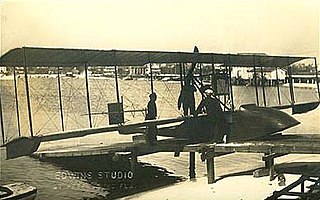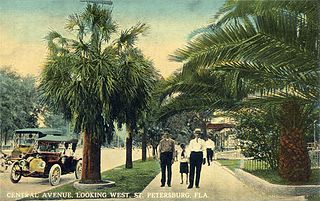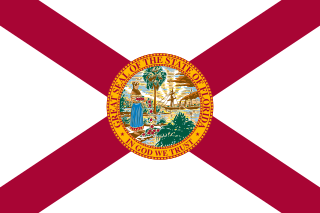
An airline is a company that provides air transport services for traveling passengers or freight. Airlines use aircraft to supply these services and may form partnerships or alliances with other airlines for codeshare agreements, in which they both offer and operate the same flight. Generally, airline companies are recognized with an air operating certificate or license issued by a governmental aviation body. Airlines may be scheduled or charter operators.

Juan Terry Trippe was an American commercial aviation pioneer, entrepreneur and the founder of Pan American World Airways, one of the iconic airlines of the 20th century. He was involved in the introduction of the Sikorsky S-42, which opened trans-Pacific airline travel, the Boeing 307 Stratoliner which introduced cabin pressurization to airline operations, the Boeing 707 which started a new era in low cost jet transportation, and the Boeing 747 jumbo jets. Trippe's signing of the 747 contract coincided with the 50th anniversary of Boeing. He also founded InterContinental Hotels & Resorts.

Tampa International Airport is an international airport six miles (9.7 km) west of Downtown Tampa, in Hillsborough County, Florida, United States. The airport is publicly owned by Hillsborough County Aviation Authority (HCAA). The airport serves 100 non-stop destinations throughout North America, Central America, the Caribbean and Europe across multiple carriers.
Silver Airways is a regional airline in the United States with its headquarters in Hollywood, Florida, near Fort Lauderdale. It was founded in 2011 with assets from the former Gulfstream International Airlines, and currently operates scheduled flights from its hubs in Fort Lauderdale, Orlando, and Tampa, Florida, as well as San Juan, Puerto Rico. The airline started flying on December 15, 2011.

St. Pete–Clearwater International Airport is a public/military airport in Pinellas County, Florida, United States, serving the Tampa Bay Area. It is right on the northeast municipal boundary of Pinellas Park, 9 miles (14 km) north of downtown St. Petersburg, 7 miles (11 km) southeast of Clearwater, and 17 miles (27 km) southwest of Tampa.

Brendan Airways, LLC, doing business as USA3000 Airlines, was a U.S. airline headquartered in Newtown Township, Delaware County, Pennsylvania. It operated both scheduled and charter service with a fleet of five Airbus A320 aircraft. The airline's last flight departed on January 30, 2012.
William A. "Pat" Patterson was the President of United Airlines from 1934 until 1966.

Antony Habersack Jannus, more familiarly known as Tony Jannus, was an early American pilot whose aerial exploits were widely publicized in aviation's pre-World War I period. He flew the first airplane from which a parachute jump was made, in 1912. Jannus was also the first airline pilot, having pioneered the inaugural flight of the St. Petersburg–Tampa Airboat Line on January 1, 1914, the first scheduled commercial airline flight in the world using heavier-than-air aircraft. The Tony Jannus Award, created to perpetuate his legacy, recognizes outstanding individual achievement in the scheduled commercial aviation industry and is conferred annually by the Tony Jannus Distinguished Aviation Society founded in Tampa, Florida, in 1963.

William Douglas Parker is an American businessman who is the chairman of American Airlines Group, the parent company of American Airlines. Parker previously served as chief executive officer of the airline from 2001 to 2023.

Robert Forman Six was an American businessman who was the CEO of Continental Airlines from 1936 to 1980. Beginning his career in the early days of commercial aviation in the United States, he became the CEO of Continental Airlines, a major contemporary airline.

Albert Whitted Airport is a public airport in St. Petersburg, Pinellas County, Florida, United States. It is on the west edge of Tampa Bay, just southeast of downtown St. Petersburg and east of the University of South Florida St. Petersburg.
Pedro Heilbron is the CEO of Copa Holdings S.A., the parent company of the Panamanian carrier Copa Airlines and the Colombian carrier AeroRepública

The Benoist XIV, also called The Lark of Duluth, was a small biplane flying boat built in the United States in 1913 in the hope of using it to carry paying passengers. The two examples built were used to provide the first heavier-than-air airline service anywhere in the world, and the first airline service of any kind at all in the United States.

The St. Petersburg–Tampa Airboat Line was the first scheduled airline using a fixed wing aircraft. The airline provided service between St. Petersburg, Florida and neighboring Tampa across Tampa Bay, a distance of about 23 miles (37 km). It was in service from January to May 1914.
On the Wing is a 1986 IMAX film featuring a half-sized robotic Quetzalcoatlus that demonstrates principles of animal flight. Produced by the National Air and Space Museum, it also traces the early history of human flight.

Florida Airways was an American airline. Founded in part by Eddie Rickenbacker and based in the state of Florida, the airline served the southeastern United States during the mid-1920s.

Thomas W. Benoist was an American aviator and aircraft manufacturer. In an aviation career of only ten years, he formed the world's first aircraft parts distribution company, established one of the leading early American aircraft manufacturing companies and a successful flying school, and from January to April 1914 operated the world's first scheduled airline.

This region of Pinellas was first settled in the 1830s and 1840s by Odet Phillippe, a French Huguenot from Charleston, SC, along with the McMullen Family from Quitman, Georgia and the British Richard Booth family who planted citrus groves and raised cattle. Following the Civil War, during the Reconstruction era, the city was founded by John C. Williams, formerly of Detroit, who purchased the land in 1876, and by Peter Demens, who was instrumental in bringing the terminus of the Orange Belt Railway there in 1888. St. Petersburg was incorporated on February 29, 1892, when it had a population of only some 300 people.

The first aeronautical event in Florida was presented on January 28, 1878, when a balloon flew over Jacksonville. Florida has since hosted four major aviation events.
Donald Brenham McKay was the owner and editor of the Daily Times newspaper in Tampa, Florida and served several terms as Mayor of Tampa from 1910 to 1920 and from 1928 to 1931.


















